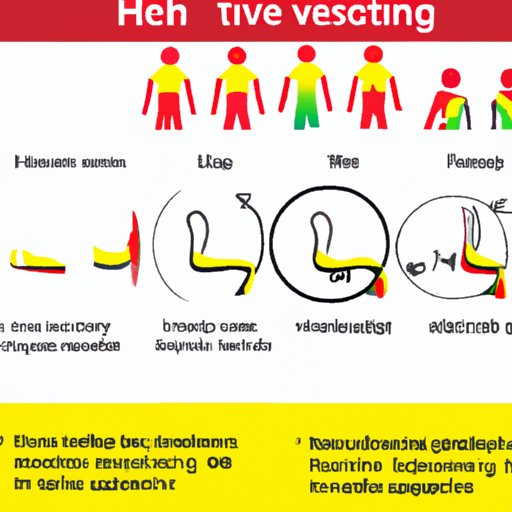
Introduction
Human immunodeficiency virus (HIV) is a life-changing virus that attacks the immune system, and can eventually lead to acquired immunodeficiency syndrome (AIDS). According to the Centers for Disease Control and Prevention (CDC), over one million Americans live with HIV, with an estimated 38,000 new diagnoses each year. While there is no cure for HIV, early detection can help people manage the virus and prevent it from progressing to AIDS. In this article, we will explore how long it takes for HIV symptoms to show up, and why it’s crucial to know when symptoms could appear.

The Timeline of HIV Symptoms: What You Need to Know
HIV has several stages of infection that can span over a decade before developing into AIDS. Each stage has its own symptoms, and the timing of symptoms can vary from person to person. The progression of HIV can be broken down into the following stages:
Stage 1: Acute HIV infection
Within two to four weeks after exposure to the virus, some people may experience flu-like symptoms, such as fever and fatigue. This is known as acute HIV infection. Other early symptoms may include headache, sore throat, and swollen lymph nodes.
Stage 2: Clinical latency
After the acute stage, HIV continues to attack the immune system, but symptoms may not appear for several years. This is known as clinical latency, or the asymptomatic stage. During this time, people with HIV may not experience any symptoms, but the virus is still active and can be transmitted to others.
Stage 3: AIDS
Without treatment, HIV can progress to stage 3, which is AIDS. At this stage, the immune system is severely damaged, and people may experience a range of symptoms related to opportunistic infections and cancers.
Is it Possible to Have HIV Without Any Symptoms? Understanding the Window Period
While some people may experience symptoms during the acute stage of HIV infection, others may not experience any symptoms for several years. This is because of the “window period” – the time between initial exposure to the virus and when the virus can be detected by testing.
During the window period, a person could be infected with HIV and still test negative for the virus. This is why it’s important to get tested regularly, especially if you have engaged in any high-risk behaviors, such as unprotected sex or sharing needles.
Recognizing the Early Signs of HIV: Symptoms to Look Out For
Early symptoms of HIV can be similar to other viral illnesses, which can make them easy to overlook. However, if you have engaged in high-risk behaviors, it’s important to get tested if you experience any of the following symptoms:
– Fever and night sweats
– Fatigue
– Body aches and joint pain
– Headache
– Swollen lymph nodes
– Skin rash
If left untreated, HIV can progress to more severe symptoms, such as rapid weight loss, chronic diarrhea, and skin sores. By getting tested early and seeking treatment, people with HIV can prevent the virus from progressing to AIDS and live long, healthy lives.
Delayed Onset of HIV Symptoms: Why Getting Tested Regularly is Important
While some people may experience HIV symptoms during the early stages of infection, others may not experience any symptoms for years. In fact, some people may not even know they are infected with HIV until later on, when the virus has progressed to a more advanced stage.
This is why it’s important to get tested regularly, especially if you have engaged in high-risk behaviors. By getting tested frequently, you can catch the virus early and begin treatment to prevent the virus from progressing.
The Role of Seroconversion in HIV Symptom Development
Seroconversion occurs when the body begins to produce antibodies in response to an HIV infection. This process usually begins one or two weeks after infection and can last for several weeks. During this time, some people may experience flu-like symptoms similar to stage 1 of HIV infection.
After seroconversion, symptoms may disappear, and the virus may remain dormant for several years before progressing to stage 3. This is another reason why it’s important to get tested regularly, even if you have previously tested negative for HIV.
Factors that Influence When HIV Symptoms Will Appear
Several factors can influence when HIV symptoms will appear, such as the person’s age and overall health status. People with compromised immune systems, such as those with cancer or autoimmune disorders, may experience symptoms earlier in the course of infection.
Additionally, people who engage in high-risk behaviors, such as unprotected sex or sharing needles, may be more likely to experience symptoms earlier on. By managing these risk factors and getting tested regularly, people can reduce their chances of experiencing severe symptoms and progressing to AIDS.
Stages of HIV Infection: How Symptoms Change Over Time
The symptoms of HIV can change over time as the virus progresses through its different stages. During the early stages of infection, symptoms may be mild and flu-like, or they may not appear at all. As the virus progresses, symptoms may become more severe and related to opportunistic infections and cancers.
It’s important to note that not all people with HIV will experience the same symptoms or progress through the stages of infection in the same way. By getting tested early and seeking treatment, people with HIV can manage the virus and prevent it from progressing to AIDS.
Conclusion
In this article, we explored the timeline of HIV infection and when symptoms typically appear. We also discussed the concept of the window period and why it’s important to get tested regularly, even if you do not have any symptoms. By getting tested early and seeking treatment, people with HIV can manage the virus and prevent it from progressing to AIDS. For more information, visit the CDC website or speak with your healthcare provider.




